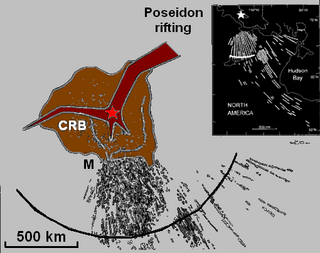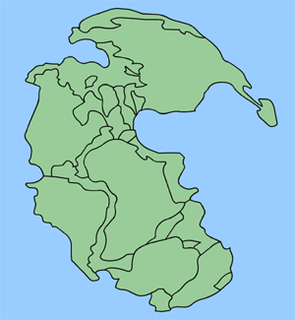 W
WThe Bridge River Ocean was an ancient ocean that existed between North America and the Insular Islands during the Paleozoic time. Similar to the earlier Slide Mountain Ocean, the Bridge River Ocean had a subduction zone on the ocean floor called the Insular Trench. The closure of the Bridge River Ocean occurred about 115 million years ago, during the mid Cretaceous period.
 W
WThe Central American Seaway, also known as the Panamanic Inter-American and Proto-Caribbean Seaway, was a body of water that once separated North America from South America. It formed in the Mesozoic during the breakup of the supercontinent Pangaea, and closed when the Isthmus of Panama was formed by volcanic activity in the late Pliocene.
 W
WThe Hudson Seaway was a major seaway of North America during the Cretaceous Period some 75 million years ago. It is named after the Hudson Bay, which currently occupies much of its extent. Although not as extensive as the Western Interior Seaway, which divided North America into eastern and western landmasses, the Hudson Seaway had major impacts on climate and migration routes by dividing the eastern half of the continent into two. Greenland was more permanently separated, by the foundered rift that created the Labrador Seaway.
 W
WThe Iapetus Ocean was an ocean that existed in the late Neoproterozoic and early Paleozoic eras of the geologic timescale. The Iapetus Ocean was situated in the southern hemisphere, between the paleocontinents of Laurentia, Baltica and Avalonia. The ocean disappeared with the Acadian, Caledonian and Taconic orogenies, when these three continents joined to form one big landmass called Euramerica. The "southern" Iapetus Ocean has been proposed to have closed with the Famatinian and Taconic orogenies, meaning a collision between Western Gondwana and Laurentia.
 W
WThe Iapetus Suture is one of several major geological faults caused by the collision of several ancient land masses forming a suture. It represents in part the remains of what was once the Iapetus Ocean. Iapetus was the father of Atlas in Greek mythology, making his an appropriate name for what used to be called the 'Proto-Atlantic Ocean'. When the Atlantic Ocean opened, in the Cretaceous period, it took a slightly different line from that of the Iapetus suture, with some originally Laurentian rocks being left behind in north-west Europe and other, Avalonian, rocks remaining as part of Newfoundland.
 W
WThe Lapland Granulite Belt is an elongate and arcuate zone of granulite rock in the Cap of the North spanning areas within Norway, Finland and Murmansk Oblast in Russia. At most the belt is 80 km broad. The main rocks of the belt are migmatized greywacke and argillites. Studies of detrital zircon show that the sedimentary protolith of the metamorphic rocks of the belt could not be older than 2900–1940 million years. The belt has norite and enderbite intrusions of calc-alkaline chemistry.
 W
WThe Mars ocean hypothesis states that nearly a third of the surface of Mars was covered by an ocean of liquid water early in the planet’s geologic history. This primordial ocean, dubbed Paleo-Ocean and Oceanus Borealis, would have filled the basin Vastitas Borealis in the northern hemisphere, a region which lies 4–5 km below the mean planetary elevation, at a time period of approximately 4.1–3.8 billion years ago. Evidence for this ocean includes geographic features resembling ancient shorelines, and the chemical properties of the Martian soil and atmosphere. Early Mars would have required a denser atmosphere and warmer climate to allow liquid water to remain at the surface.
 W
WMirovia or Mirovoi was a hypothesized superocean which may have been a global ocean surrounding the supercontinent Rodinia in the Neoproterozoic Era, about 1 billion to 750 million years ago. Mirovia may be essentially identical to, or the precursor of, the hypothesized Pan-African Ocean, which followed the rifting of Rodinia. The Panthalassa (proto-Pacific) Ocean developed in the Neoproterozoic Era by subduction at the expense of the global Mirovia ocean.
 W
WThe Mongol-Okhotsk Ocean also known as the Khangai-Khantey Ocean was an ancient ocean, present during the Mesozoic. Oceanic rocks from the ancient ocean floor are preserved in the Mongol-Okhotsk suture zone extending through Mongolia to the Sea of Okhotsk.
 W
WThe Paleo-Tethys or Palaeo-Tethys Ocean was an ocean located along the northern margin of the paleocontinent Gondwana that started to open during the Middle Cambrian, grew throughout the Paleozoic, and finally closed during the Late Triassic; existing for about 400 million years.
 W
WThe Pannonian Sea was a shallow ancient sea, where the Pannonian Basin in Central Europe is now. The Pannonian Sea existed during the Miocene and Pliocene epochs, when a 3–4 km (1.9–2.5 mi) depth of marine sediments were deposited in the Pannonian Basin.
 W
WPanthalassa, also known as the Panthalassic Ocean or Panthalassan Ocean, was the superocean that surrounded the supercontinent Pangaea. During the Paleozoic–Mesozoic transition c. 250 Ma it occupied almost 70% of Earth's surface. Its ocean floor has completely disappeared because of the continuous subduction along the continental margins on its circumference. Panthalassa is also referred to as the Paleo-Pacific or Proto-Pacific because the Pacific Ocean developed from its centre in the Mesozoic to the present.
 W
WThe Paratethys ocean, Paratethys sea or just Paratethys was a large shallow inland sea that stretched from the region north of the Alps over Central Europe to the Aral Sea in Central Asia. The sea was formed during the Oxfordian stage of the Late Jurassic as an extension of the rift that formed the Central Atlantic Ocean and was isolated during the Oligocene epoch. It was separated from the Tethys Ocean to the south by the formation of the Alps, Carpathians, Dinarides, Taurus and Elburz mountains. During its long existence the Paratethys was at times reconnected with the Tethys or its successors, the Mediterranean Sea or Indian Ocean. From the Pliocene epoch onward, the Paratethys became progressively shallower. Today's Black Sea, Caspian Sea, Aral Sea, Lake Urmia, Namak Lake and others are remnants of the Paratethys Sea.
 W
WThe Piemont-Liguria basin or the Piemont-Liguria Ocean was a former piece of oceanic crust that is seen as part of the Tethys Ocean. Together with some other oceanic basins that existed between the continents Europe and Africa, the Piemont-Liguria Ocean is called the Western or Alpine Tethys Ocean.
 W
WThe Poseidon Ocean was an ocean that existed during the Mesoproterozoic period of the geologic timescale. It began to form when a hotspot collided with lithosphere that was already in an extensional regime that allowed rifting to occur at the onset of hotspot volcanism that created the Mackenzie Large Igneous Province. This hotspot, known as the Mackenzie hotspot, produced passive rifting to form a triple junction. As two of the rift arms continued to grow, they created the Poseidon Ocean basin. The third rift arm failed to open fully, creating an aulacogen.
 W
WThe Svecofennian orogeny is a series of related orogenies that resulted in the formation of much of the continental crust in what is today Sweden and Finland plus some minor parts of Russia. The orogenies lasted from about 2000 to 1800 million years ago during the Paleoproterozoic Era. The resulting orogen is known as the Svecofennian orogen or Svecofennides. To the west and southwest the Svecofennian orogen limits with the generally younger Transscandinavian Igneous Belt. It is assumed that the westernmost fringes of the Svecofennian orogen have been reworked by the Sveconorwegian orogeny just as the western parts of the Transscandinavian Igneous Belt has. The Svecofennian orogeny involved the accretion of numerous island arcs in such manner that the pre-existing craton grew with this new material from what is today northeast to the southwest. The accretion of the island arcs was also related to two other processes that occurred in the same period; the formation of magma that then cooled to form igneous rocks and the metamorphism of rocks.
 W
WThe Slide Mountain Ocean was an ancient ocean that existed between the Intermontane Islands and North America beginning around 245 million years ago in the Triassic period. It is named after the Slide Mountain Terrane, which is composed of rocks from the ancient oceanic floor. There was a subduction zone on the Slide Mountain Ocean's floor called the Intermontane Trench where the Intermontane Plate was being subducted under North America. The floor of the Slide Mountain Ocean was pushed up onto the ancient margin of North America.
 W
WA superocean is an ocean that surrounds a supercontinent. It is less commonly defined as any ocean larger than the current Pacific Ocean. Named global superoceans include Mirovia, which surrounded the supercontinent Rodinia, and Panthalassa, which surrounded the supercontinent Pangaea. Pannotia and Columbia, along with landmasses before Columbia, were also surrounded by superoceans.
 W
WThe Tethys Ocean, also called the Tethys Sea or the Neotethys, was an ocean during much of the Mesozoic Era located between the ancient continents of Gondwana and Laurasia, before the opening of the Indian and Atlantic oceans during the Cretaceous Period.
 W
WThe Valais Ocean is a subducted oceanic basin which was situated between the continent Europe and the microcontinent Iberia or so called Briançonnais microcontinent. Remnants of the Valais ocean are found in the western Alps and in tectonic windows of the eastern Alps and are mapped as the so-called "north Penninic" nappes.
 W
WThe Western Interior Seaway was a large inland sea that existed during the mid- to late Cretaceous period as well as the very early Paleogene, splitting the continent of North America into two landmasses, Laramidia to the west and Appalachia to the east. The ancient sea stretched from the Gulf of Mexico and through the middle of the modern-day countries of the United States and Canada, meeting with the Arctic Ocean to the north. At its largest, it was 2,500 feet (760 m) deep, 600 miles (970 km) wide and over 2,000 miles (3,200 km) long.